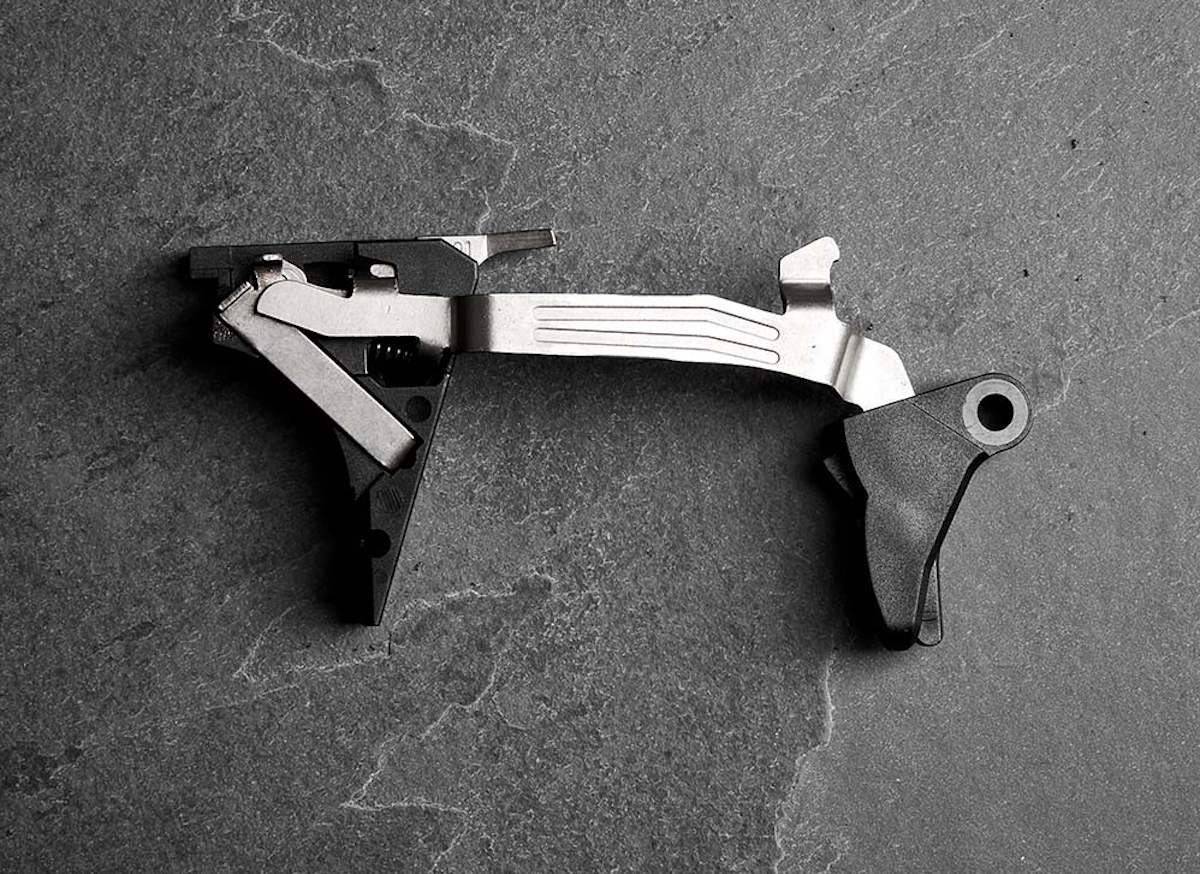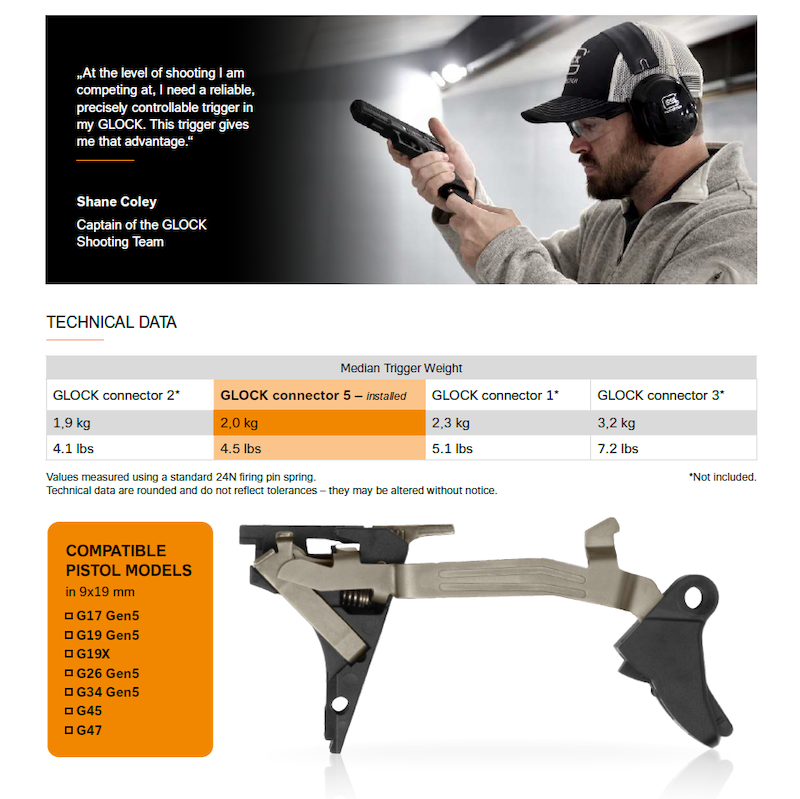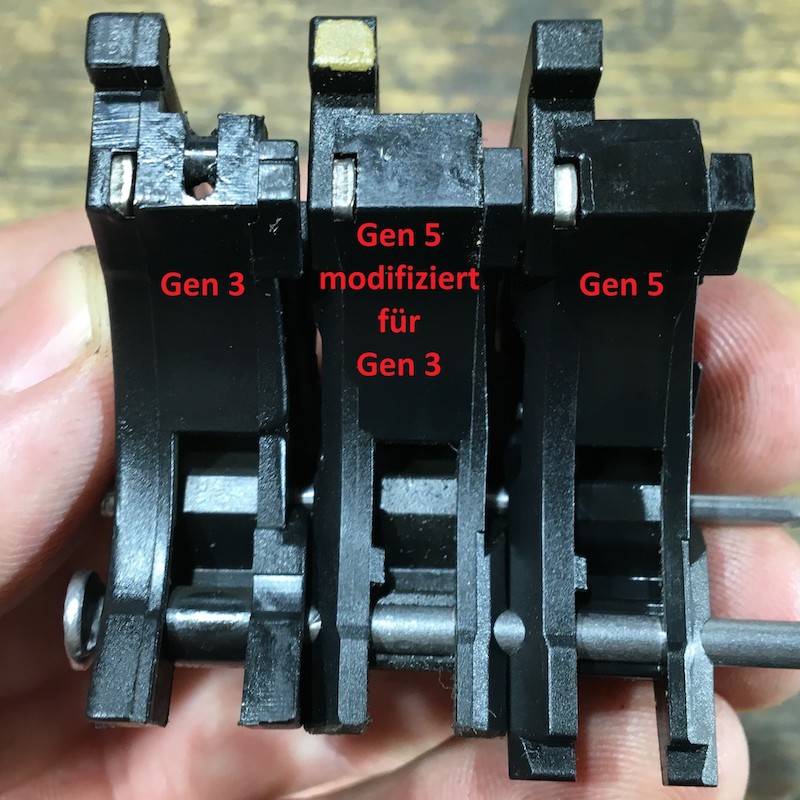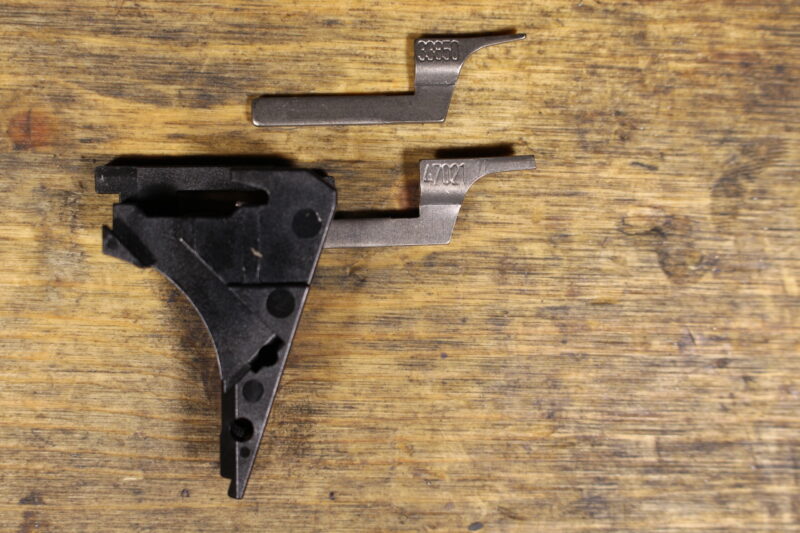Get the weekly SPARTANAT newsletter.
Your bonus: the free E-Book from SPARTANAT.

REVIEW: The new GLOCK Performance Trigger
The GLOCK pistol is the ultimate law enforcement pistol. GLOCK is the ultimate law enforcement supplier. In the name of the new trigger, the words "Sport", "Match" or "Competition" do not appear. It is clear where this is heading.
On February 17th, it was time for Christian from KAWATEC: GLOCK Performance Trigger picked up, installed in three different GLOCK pistols, lightly oiled, manually cycled - cocked and fired several times - and then off to the shooting range. Here is his test report:

A little warning in between, don't be alarmed: With plastic parts in combination with metal and tight new springs without lubrication, it is completely normal for it to be a bit stiff at the beginning, the parts need to break in and the spring tension decreases. Plastic surfaces are not really precise in injection molding, but that's something you know. Forming an opinion based on a freshly installed trigger is not really helpful. Let it break in and shoot a little. The characteristics change significantly at the beginning.
My conclusion: My expectations and assumptions were met 100 percent. The main target group of the new GLOCK trigger are surely tactical shooters in the Military & Law Enforcement sector and professional gun carriers, but also many (not all) sports shooters will be thrilled. As I suspected, the GLOCK Performance Trigger has a clear initial resistance that is not too light until you reach the breakpoint. Then the trigger cleanly releases, the trigger pull is very short, and the reset is also quite short. The reset for a law enforcement trigger is also very short but clearly present. Fast targeted shot sequences are very possible.
The GLOCK Performance Trigger comes standard with the "dot" control spring, but you can decide for yourself which control spring to install. If you want it a bit lighter, then use the "Minus" control spring, if you want it a bit tighter, then you can install the control spring without marking or the "Plus" control spring, but it's best to try it out for yourself and decide. All safety features of the GLOCK Safe Action® System are still retained. Sports shooters who prefer the typical "Zero" triggers will probably not warm up to the GLOCK Performance Trigger, but that was to be expected. Personally, I prefer the characteristics of law enforcement triggers, in case of emergency, I want to be on the safe side without collateral damage. The GLOCK Performance Trigger will definitely remain in my EDC GLOCK.
A few measurements from a GLOCK 19 Gen5 with well-used triggers
- Standard trigger with "Minus" control spring -> ~1.9 kg trigger weight
- GLOCK Performance Trigger with "dot" control spring -> ~1.65 kg trigger weight
- GLOCK Performance Trigger with "Minus" control spring -> ~1.45 kg trigger weight
Compatibility:
Officially, the GLOCK Performance Trigger only fits standard-width Gen5 GLOCK pistols in 9x19 caliber. Is that really the case? We were curious.
WARNING: Only GLOCK CERTIFIED ARMOURERS are allowed to install the GLOCK Performance Trigger and any "unprofessional" modifications will result in the loss of warranty or exclusion of liability. But has that ever deterred private tuning measures?

This is how compatible the Gen5 GLOCK Performance Trigger is:
- For Gen4 pistols, the Gen5 trigger unit fits into the Gen4 frame without further modification, and the Gen5 cover plate must be installed in the slide.
- With Gen1 to Gen3 pistols, the Gen5 trigger unit does not fit without modification, a little filing must be done on the underside of the control block, difficulty level "2 Left Hands," then the Gen5 trigger unit fits into the Gen3 frame. Here, the Gen-5 cover plate must also be installed.

- For the GLOCK 23 Gen4 in .40 S&W caliber, in addition to the Gen5 cover plate, the extractor of the GLOCK 23 must also be installed in the control block of the GLOCK Performance Trigger. This was tested only in the workshop without firing.
 HERE directly at KAWATEC is the GLOCK Performance Trigger available for 99 Euro.
HERE directly at KAWATEC is the GLOCK Performance Trigger available for 99 Euro.
KAWATEC on the Internet
Basic knowledge on the topic of GLOCK and triggers
GLOCK is the official supplier of self-loading pistols to authorities. The GLOCK pistol was developed as a service pistol, the design is simple, effective, functionally safe, and reliable, meaning that a shot will only be fired when the trigger is consciously pulled. The modular design without pins and almost completely without screws (since Gen3, there is a fixing screw for the front sight, and since Gen4, there are mounting screws for the MOS plates) is brilliant.
The trigger is a typical law enforcement trigger that has hardly changed since 1980. It must be noted here that the trigger is definitely not a match trigger; the requirements for a law enforcement weapon are completely different. It is mainly about absolute safety to prevent accidental firing, even when the finger is on the trigger and pressure has been applied. The history must also be considered. Most self-loading pistols initially had manually operated external safeties, and revolvers did not need safety features because the cocking mechanisms were housed and the double-action trigger pull was very heavy, making accidental firing highly unlikely.
When the first armies introduced self-loading pistols without manually operated external safeties, various but very similar concepts were developed to ensure safety. The triggers were designed to have characteristics similar to double-action revolver triggers but without the need to operate a hammer. The Steyr Roth M1907 used a partially cocked firing pin lock for this purpose, and the CZ38 incorporated a Double Action Only (DAO) system. The Sauer service model from 1930 already included a drop safety in addition to the firing pin lock. GLOCK was groundbreaking with its pistol concept and its partially cocked firing pin lock and trigger safety.
However, it has now become standard practice to use fully cocked firing pin locks in many service pistols. The great advantage lies in the very good trigger characteristics. There is a clean take-up until a more or less defined pressure point where the shot cleanly breaks. With the partially cocked firing pin lock, more pressure must always be applied to cock the firing pin until, eventually, the shot is fired without warning; a pressure point is usually not present or barely noticeable. It was long overdue for GLOCK to offer at least one more trigger option.
What the authority wants vs. what the sports shooter wants
Authorities typically want a clear take-up, a clearly defined pressure point, and a noticeable reset. This makes it very difficult for unintentional firing to occur, even if the soldier/policeman has their finger on the trigger and has already applied some pressure.
The typical sports shooter ideally wants 0 take-up, 0 trigger resistance, 0 overtravel when firing, and 0 reset. They prefer touching the trigger and the shot breaking.
In an emergency, a tactical user must be prepared for the possibility of being fired upon and in this high-stress situation, they must quickly determine whether the possible target is friend or foe with their finger on the trigger. With a typical sports trigger, there would likely be many instances of unintentional firing and collateral damage in such situations.
Many authorities base their procurement of 9x19mm service pistols on the "Technical Guideline (TR) Pistols in 9 mm x 19 Caliber" from the German Police University, which sets out the above principles with minimum values (trigger path, reset, trigger resistance, etc.).
GLOCK on the Internet
SPARTANAT is the online magazine for Military News, Tactical Life, Gear & Reviews.
Send us your news: [email protected]
Ad
similar
Get the weekly SPARTANAT newsletter.
Your bonus: the free E-Book from SPARTANAT.


